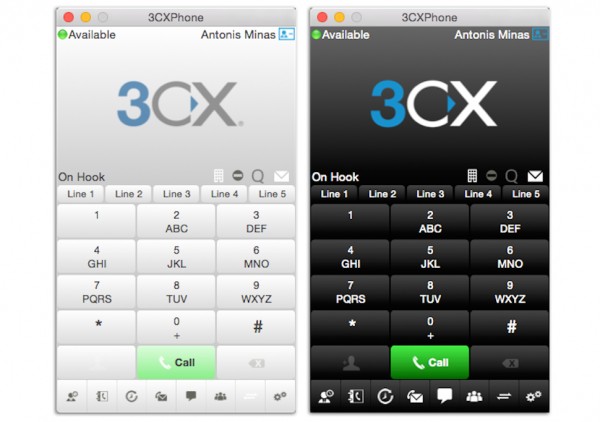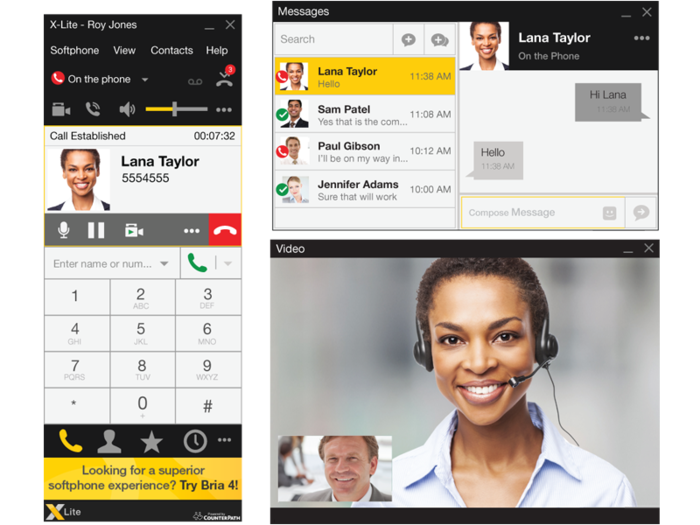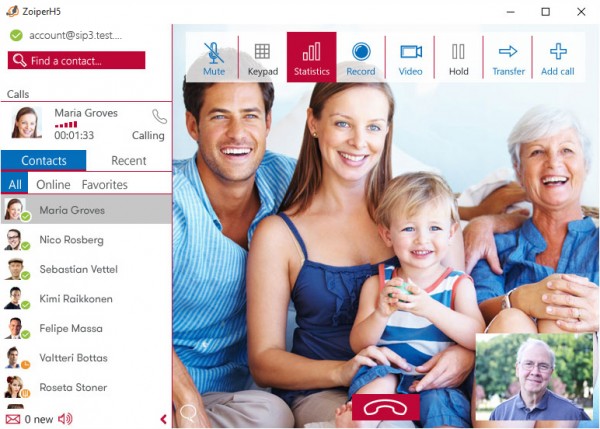Find the best VoIP Softphones
Compare Products
Showing 1 - 20 of 79 products
Sort by
Reviews: Sorts listings by the number of user reviews we have published, greatest to least.
Sponsored: Sorts listings by software vendors running active bidding campaigns, from the highest to lowest bid. Vendors who have paid for placement have a ‘Visit Website’ button, whereas unpaid vendors have a ‘Learn More’ button.
Avg Rating: Sorts listings by overall star rating based on user reviews, highest to lowest.
A to Z: Sorts listings by product name from A to Z.
RingCentral MVP
RingCentral MVP
RingEX is a cloud-based business communications solution that offers tools for Messaging, Video and Phone. Core features of the solution include conferencing, auto-recording and unlimited long-distance and local calling. RingEX ...Read more about RingCentral MVP
OnSIP
OnSIP
OnSIP Hosted OnSIP Hosted VoIP by Junction Networks is a cloud-based phone solution that offers businesses across various industry verticals PBX feature such as auto attendants and voicemail-to-email. Unified communications (...Read more about OnSIP
ULTATEL Cloud Business Phone System
ULTATEL Cloud Business Phone System
ULTATEL enables people to work together and get the information they need to do their best work, anywhere they are. Our cloud platform brings together phone, video, messaging, texts and business apps, allowing people to connect, ...Read more about ULTATEL Cloud Business Phone System
LiveAgent
LiveAgent
LiveAgent is an online Help Desk solution for e-commerce businesses at the small and midsize levels. The platform offers live chat application, ticket management, online self-service portals, and change and license management, all...Read more about LiveAgent
Talk with us for a free
15-minute consultationSoftware Advice is free because vendors pay us when they receive sales opportunities.
This allows us to provide comprehensive software lists and an advisor service at no cost to you.
This allows us to provide comprehensive software lists and an advisor service at no cost to you.
Meet Eric, a software expert who has helped 1,534 companies select the right product for their needs.
Talk with us for a free
15-minute consultationSoftware Advice is free because vendors pay us when they receive sales opportunities.
This allows us to provide comprehensive software lists and an advisor service at no cost to you.
This allows us to provide comprehensive software lists and an advisor service at no cost to you.
Tell us more about your business and an advisor will reach out with a list of software recommendations customized for your specific needs.
STEP 1 OF 4
How many phones do you have?
Bitrix24
Bitrix24
Bitrix24 is an online workspace for small, medium, and large businesses. It features over 35 cross-integrated tools, including CRM, tasks, Kanban board, Gantt chart, messenger, video calls, file storage, workflow automation, and m...Read more about Bitrix24
GoTo Connect
GoTo Connect
GoTo Connect is the all-in-one phone, meeting and messaging software built for SMBs. It boasts an enterprise-class phone system with 100+ features with inclusive minutes for local, long distance & international calls; video and au...Read more about GoTo Connect
Aircall
Aircall
Aircall is a cloud-based business phone and call center system that helps manage and streamline customer support and sales engagement operations. Designed for offices and teams in remote areas, it enables users to integrate the so...Read more about Aircall
3CX
3CX
3CX Phone System is an open standards communications solution, suitable for any sized business that wants all the features of an advanced contact center at a fraction of the cost. 3CX can take your business communications to the n...Read more about 3CX
Ringover
Ringover
Ringover is the no.1 business phone system that gives you unlimited calls to 110 countries, video conferencing, SMS and group messaging, call recording, call whispering and more features focused on improving your teams productivit...Read more about Ringover
Grasshopper
Grasshopper
Grasshopper is a cloud-based virtual phone service that helps small to midsize enterprises establish communication with customers through local and toll-free numbers. It provides several modules, including call forwarding, multipl...Read more about Grasshopper
CloudTalk
CloudTalk
CloudTalk is a contact center management solution that enables businesses to streamline communications with teams and customers using virtual call systems. It allows executives to manage inbound/outbound calls, extract interaction...Read more about CloudTalk
RingCentral Contact Center
RingCentral Contact Center
RingCentral's leading cloud contact center offers skill-based routing, agent management, real-time insights, and more to empower your employees to deliver better customer experiences. With the right tools, your agents can meet you...Read more about RingCentral Contact Center
JustCall
JustCall
JustCall is a powerful AI-driven customer communication platform enabling instant connections through Voice, SMS, and WhatsApp. It simplifies workflow automation and team coaching within a unified interface, seamlessly integrating...Read more about JustCall
Acefone
Acefone
Acefone is a VoIP solution designed to help businesses in construction, retail, real estate, healthcare, finance, education and other sectors manage missed client calls, define ring strategies for different phone numbers and contr...Read more about Acefone
CallTrackingMetrics
CallTrackingMetrics
CallTrackingMetrics is a cloud-based call tracking and contact center solution for businesses and agencies that helps with tracking campaigns, reaching new audiences through integrated text marketing and online forms and using int...Read more about CallTrackingMetrics
Zoiper
Zoiper
Zoiper is an on-premise and cloud-based softphone solution that caters to service providers, call centers, VoIP integrators, mobile operators and businesses that require softphones independent of their service provider. It aggrega...Read more about Zoiper
Bria
Bria
Bria is a softphone and Unified Communications solution developed by CounterPath. With Bria, businesses can provide their employees with the means to take business-line calls on the go and work remotely from both desktop and mobil...Read more about Bria
G12 Communications
G12 Communications
Communication is the catalyst of innovation in virtually every industry, whether it’s building a cohesive workplace culture, providing the platforms to connect, or establishing long-term business relationships. Embracing the mode...Read more about G12 Communications
Squaretalk
Squaretalk
Squaretalk is a cost-effective, scalable, and simple-to-use cloud communications platform that gives your sales and support teams tremendous tools to boost efficiency and productivity. Your sales and support representatives will ...Read more about Squaretalk
Cisco Unified Communications Manager
Cisco Unified Communications Manager
Cisco Unified Communications Manager is a platform for integrating business communication technologies such as telephony, video conferencing, presence information, call recording, web conferencing and messaging. It enables adminis...Read more about Cisco Unified Communications Manager
Popular Comparisons
Buyers Guide
Last Updated: March 16, 2023With the vast number of VoIP softphone products on the market, choosing the right solution for your phone system can be daunting. (Technically, all softphones are for VoIP service, since they’re essentially software for placing calls over the Internet.) To help make your decision easier, we’ve compiled this guide.
We’ll outline the common features of softphones and give a rundown of popular products to help you make the right decision for your business. We’ll look at:
Common Functions of VoIP Softphones
Crucial Considerations for Buyers
What Is a VoIP Softphone?
The name says it all: software phone. Softphones are software applications that run on devices (laptops, smartphones, tablets etc.) with Internet connections and allow you to make and receive calls. Softphones are thus designed for Internet phone service, commonly known as Voice over Internet Protocol (VoIP), rather than traditional phone service.
A VoIP softphone is perhaps easiest to understand when compared to an IP phone i.e., a hardware office phone designed to make calls over the Internet using a business VoIP service rather than traditional land lines.
Both IP phones and softphones serve as endpoints to which VoIP phone systems connect calls, but one is software and the other is hardware.
Some businesses choose to deploy softphones rather than hardware phones as phone system extensions. For instance, if your employees work remotely, it makes more sense to connect the phone system to applications on their laptops than to desk phones in an office they rarely see. Additionally, you can deploy softphones alongside desk phones and connect the same extension to both endpoints. This gives your employees more flexibility in their communications options.
Softphone-only deployments are gaining in popularity and can also help keep the costs of switching to VoIP down, since IP phones can be expensive.
Common Functions of VoIP Softphone Software
VoIP softphones often include the following core capabilities:
Voice calling | The key functionality of softphones. Make and receive calls through your Internet connection. |
Video calling | Place and receive video calls on devices with cameras. (Note that video calling is not the same as video conferencing, which frequently requires a more advanced application.) |
Call history | Track incoming and outgoing calls. |
Voicemail | Let callers leave voice messages when you’re not available. Listen to voice messages and return calls. |
On-demand call recording | Users can frequently initiate on-demand call recording from the softphone user interface (UI). |
Directory of contacts/presence | Just like your smartphone, a softphone has a directory of contacts. The difference is that softphones also generally display which contacts are currently online (a feature known as presence). |
Call transferring | Softphones allow you to transfer calls to contacts in your organization. |
Click-to-dial | Because softphones are installed on your device, they allow you to click on links on web pages and in emails in order to place calls automatically, without touching a keypad or picking up a receiver. |
More advanced softphones offer a smorgasbord of features beyond these basic capabilities, and are known as unified communications (UC) clients. Generally, these clients are offered directly via the vendor of your phone system or UC system, whereas softphones are commonly offered by third-party vendors. If you’re just looking for basic inbound and outbound calling capabilities, a softphone will generally be enough, while UC clients are for supporting advanced communications like multi-party video conferencing on smartphones and tablets.
Benefits of VoIP Softphones
There are many benefits of choosing a softphone over, or in addition to hardphones:
Reduce costs by reducing hardware. Softphone software gives you the option to forego traditional office phones. You’ll save money by not having to buy extra hardware in the first place.
Integrate with computer systems. Because softphones use your local computer network, they also integrate with your existing computer-based systems. Many softphone applications, including the ones mentioned above, can integrate with contact databases such as Outlook, Thunderbird and Mac address books. Softphones with click-to-dial allow you to place calls from your customer relationship management (CRM) software, Web browser or accounting system. This is a highly useful feature for call center agents and other employees that have to place lots of outbound calls (e.g those in accounts receivable).
Place calls through Wi-Fi. Normally, when you make a call with your cellphone, it goes over a cellular network and you have to pay per-minute rates as well as prohibitively expensive roaming fees if you’re out of range of your providers’ network. Softphones allow you to place calls over a Wi-FI internet connection, so you bypass the cellular network and avoid per-minute rates and roaming charges. You still need to pay for the data connection or the Wi-Fi connection unless it’s public. This feature results in significant savings for employees who travel abroad frequently.
The Vendor Landscape
There are both free and paid softphones on the market. To help you determine which softphone solution is right for you, let’s take a look at a few popular products.
3CX. 3CX offers both cloud and on-premise business phone systems. Manage calls from your desktop and use your computer to make and receive calls.
3CX has softphones for both Windows and Mac, and it includes native Session Initiation Protocol (SIP) apps for Android and iOS.

3CX softphone for Mac
Bria X-Lite. One of Bria X-Lite’s most attractive qualities is that it’s free. Several softphone vendors offer “freemium” versions that may have only limited functionalities and/or be supported by ads.
Bria X-Lite includes functionalities for voice and video calls, instant messaging and voicemail support. This free solution is meant to act as a stepping stone to the paid option, Bria 4. It is compatible with Windows and Mac systems.

Bria X-Lite softphone, video calling and chat
Zoiper. Another notable option on the market is Zoiper. Along with voice and video calling, it offers call recording, call transfer and auto-answering. It also has native conferencing, so you can conduct conference calls without relying on a third-party service. It works on Windows, Mac and Linux systems.

Zoiper video calling
Crucial Considerations for Buyers
Free vs. paid softphones. Many softphone vendors offer what are called “freemium” clients (e.g., Bria X-Lite) to encourage customers to eventually pay to upgrade. Some freemium products rely heavily on advertisements within the application to stay free.
These clients can work well for smaller companies or companies with limited needs. However, larger enterprises or those seeking more complex functionalities will need a more advanced client.
Phone system/headset compatibility. The #1 factor that should guide your choice of a softphone is compatibility. The softphone needs to be supported by your phone system, so check with your vendor or your vendor’s channel partner about this issue. Most major vendors list compatible softphones on their websites or in product literature. Additionally, if you’re planning to use the softphone in conjunction with a headset in a call center environment, you need to ensure that the softphone is also compatible with the specific brand of headset you’re using.
Softphone platforms. Softphones are trending toward OS agnosticism. Users want apps that run on Windows, Mac and Linux, as well as on smartphone operating systems such as Android and iOS. Thus, many providers are now offering their products on many different platforms, and they’re developing mobile clients.







